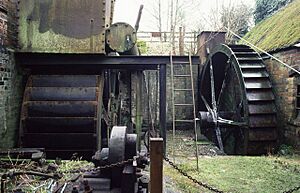Churchill Forge Mill facts for kids
Churchill Forge Mill is a special place in the village of Churchill, Worcestershire. It's one of the very few water-powered forge mills left in the UK that is still in good condition. This makes it a really important part of the industrial history of the West Midlands area. A "forge mill" is a workshop where metal is shaped using hammers powered by water. Parts of Churchill Forge Mill have been fixed up and can now work again. The Churchill Forge Trust takes care of it and runs it.
Contents
The History of Churchill Forge Mill
Churchill Forge Mill is located in the valley of the Ganlow Brook. Long ago, in the Middle Ages, a dam was built here. This created a pond that held water. A special gate, called a sluice, would let water flow from the pond. This water then turned the mill's big wheels.
Early Records of the Mill
The first known record of Churchill Forge is from a document called a charter in 1238. In this charter, a man named Robert de Hurcote gave Hugh Drugel "all the land of Churchill, along with the right to choose the church's priest and the mill." This gift was for Hugh's marriage to Robert's sister, Margery. Robert had paid money to the Lord of Hagley for this agreement. He also paid a yearly rent to the Prior of Dudley for the mill. Over time, the mill changed owners many times. By the late 1500s, records mention a "blade mill" and its pond. A blade mill was a place where blades and tools were made.
The Bache Family's Role
The Bache family played a big part in developing the brick mill you see today. They had lived in the area for a long time. Their family members still own Churchill Forge even now. In the 1700s, William Bache (born 1743, died 1817) ran a nearby forge called Stakenbridge Forge. His son, also named William, combined the two businesses. This happened after he married the daughter of Churchill Forge's previous owner in 1796. After that, a member of the Bache family always owned or had a share in the business.
After World War I
After World War I, Benjamin Bache returned to Churchill. He had been working in a forge in Stourbridge. He reopened the Churchill forge, which had closed during the war because there weren't enough workers. Benjamin and his son, Claude, started a business together. They called it "Benjamin Bache and Son, Spade, Blade, Shovel and Ladle Works." Claude Bache continued to run the business after his father passed away. He retired in 1969. Today, you can still see an old gate at the mill entrance. It has the Bache family name written vertically down the middle.
How the Mill Worked
From the 1700s onwards, Churchill Forge was used to make farm tools. These included spades, shovels, forks, rakes, hoes, and blades for cultivating soil. The mill also made special tools for local industries. For example, it made unique shovels called "skippets" for the nearby salt works in Droitwich. It also produced pouring ladles for the Stourbridge glass industry and metal factories in the Black Country.
The Mill's Machinery
The main water wheel in the current building is very large. It is 17 feet across and 5 feet 3 inches wide. This wheel is connected to a strong 18-foot cast iron axle. This axle holds two of the original flywheels. These flywheels used to power large trip hammers, which pounded metal. Now, a large spur wheel on the axle turns a smaller gear. This smaller gear then powers a flat belt. This belt drives different hammers, presses, and other machines. A crank on the axle also operates a "crocodile shear." This machine can cut through mild steel. There is also an older water wheel from the 1800s. It is also 17 feet across but only 2 feet 3 inches wide. This older wheel has an oak axle. It used to power the furnace blower for the forge. It also powered two wet grindstones, which were used to sharpen tools.
Preserving the Mill
In 1979, a small group of people decided to save the mill. Some of them were descendants of the Bache family. They formed a group to protect the mill. In 1981, this group became the Churchill Forge Trust Limited. This trust has worked hard to keep the building in good repair. They also make sure the machinery stays in working order. On certain days, the mill is open for visitors. You can even see the old machinery working!


